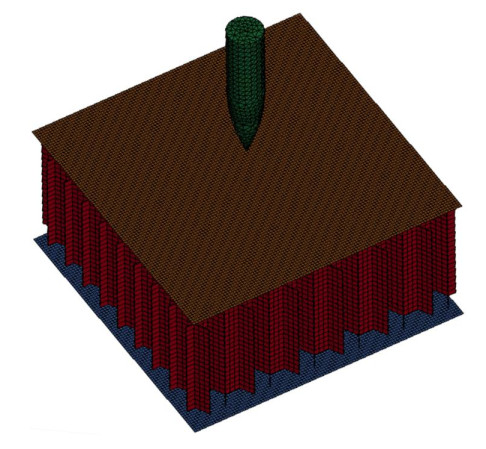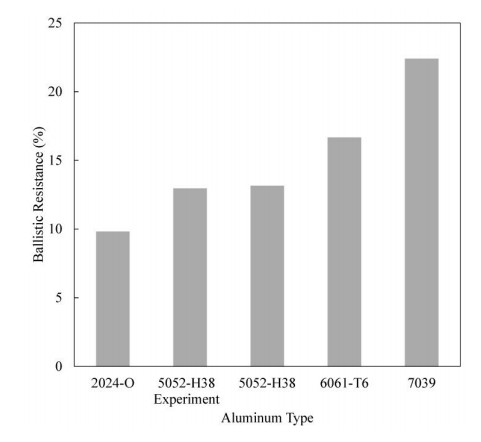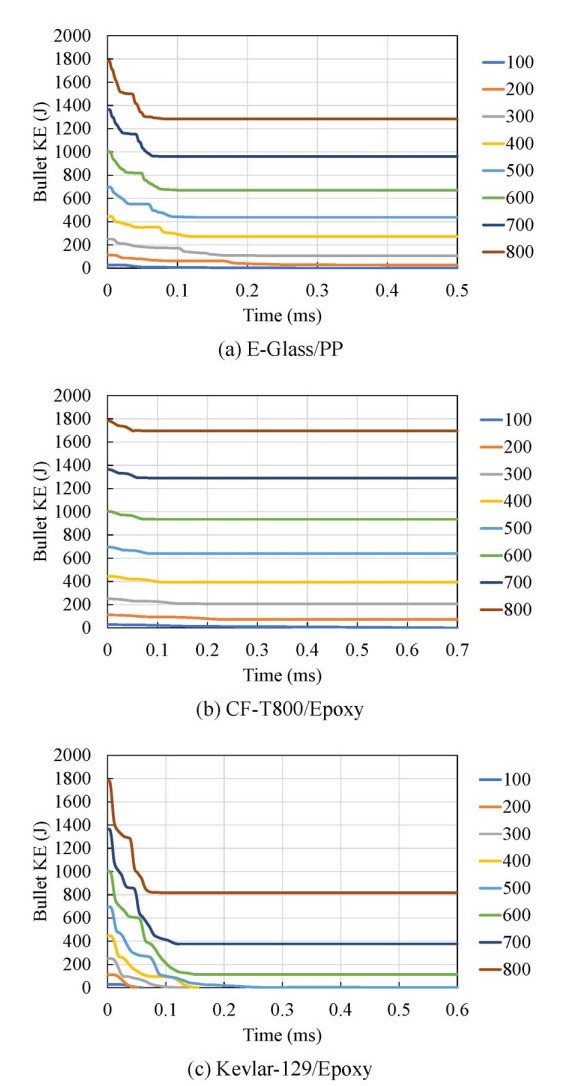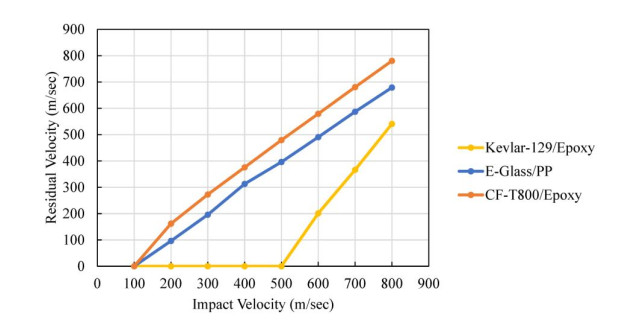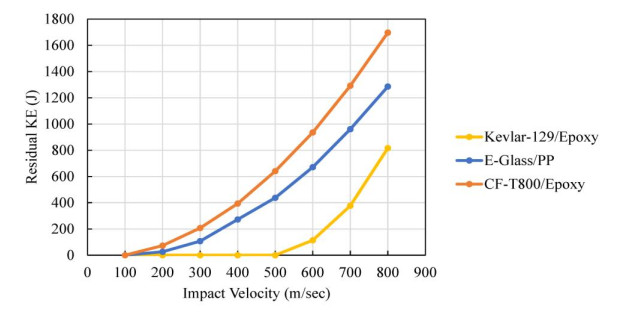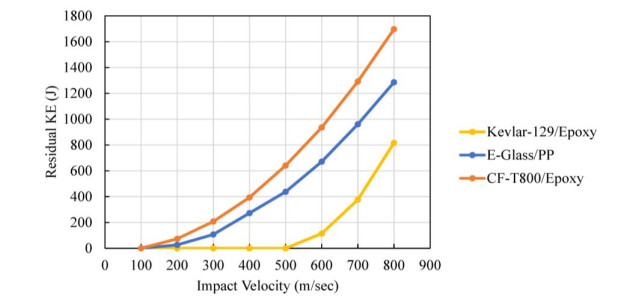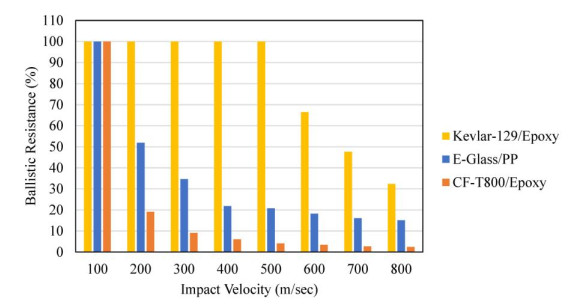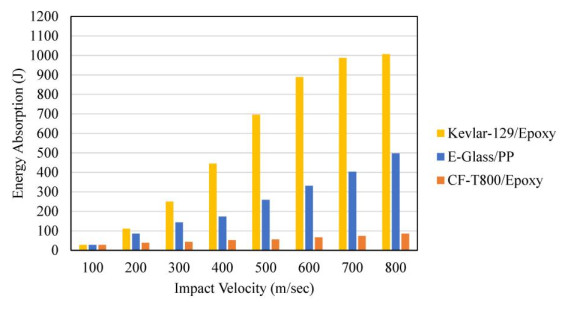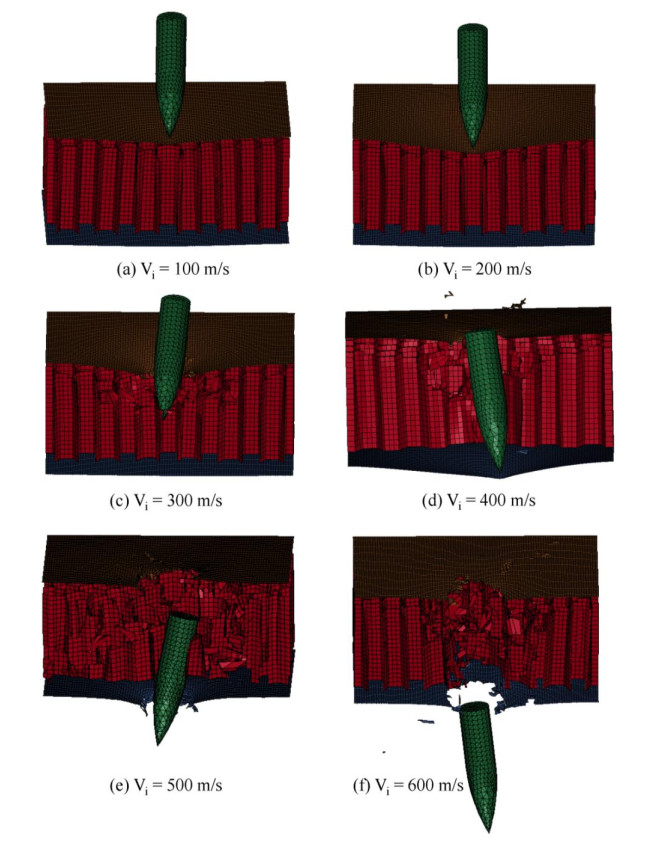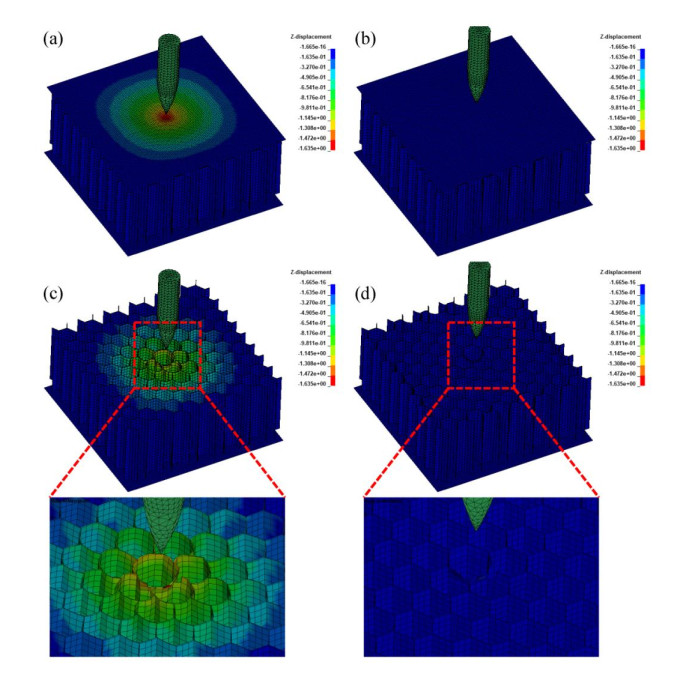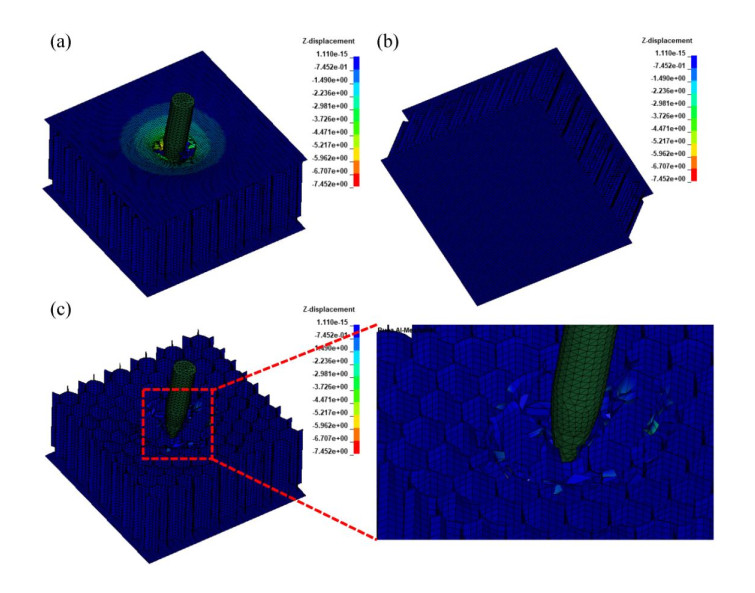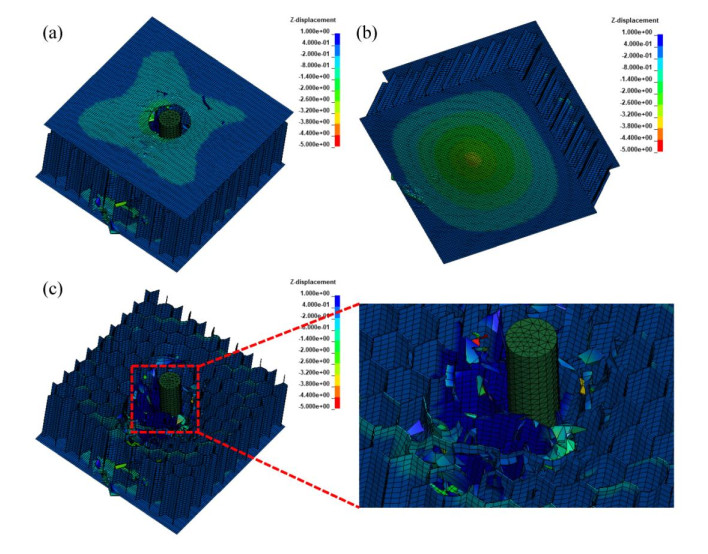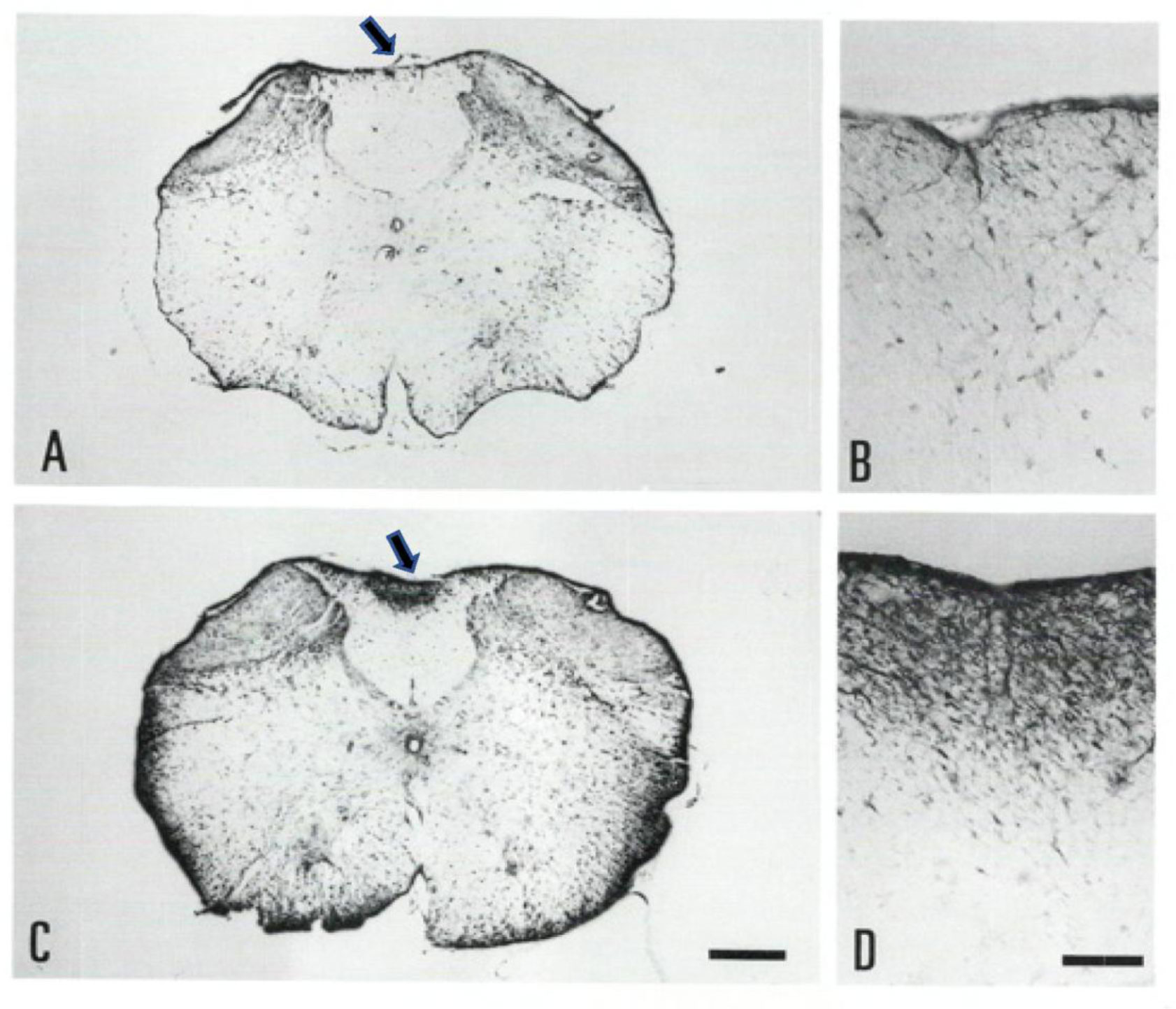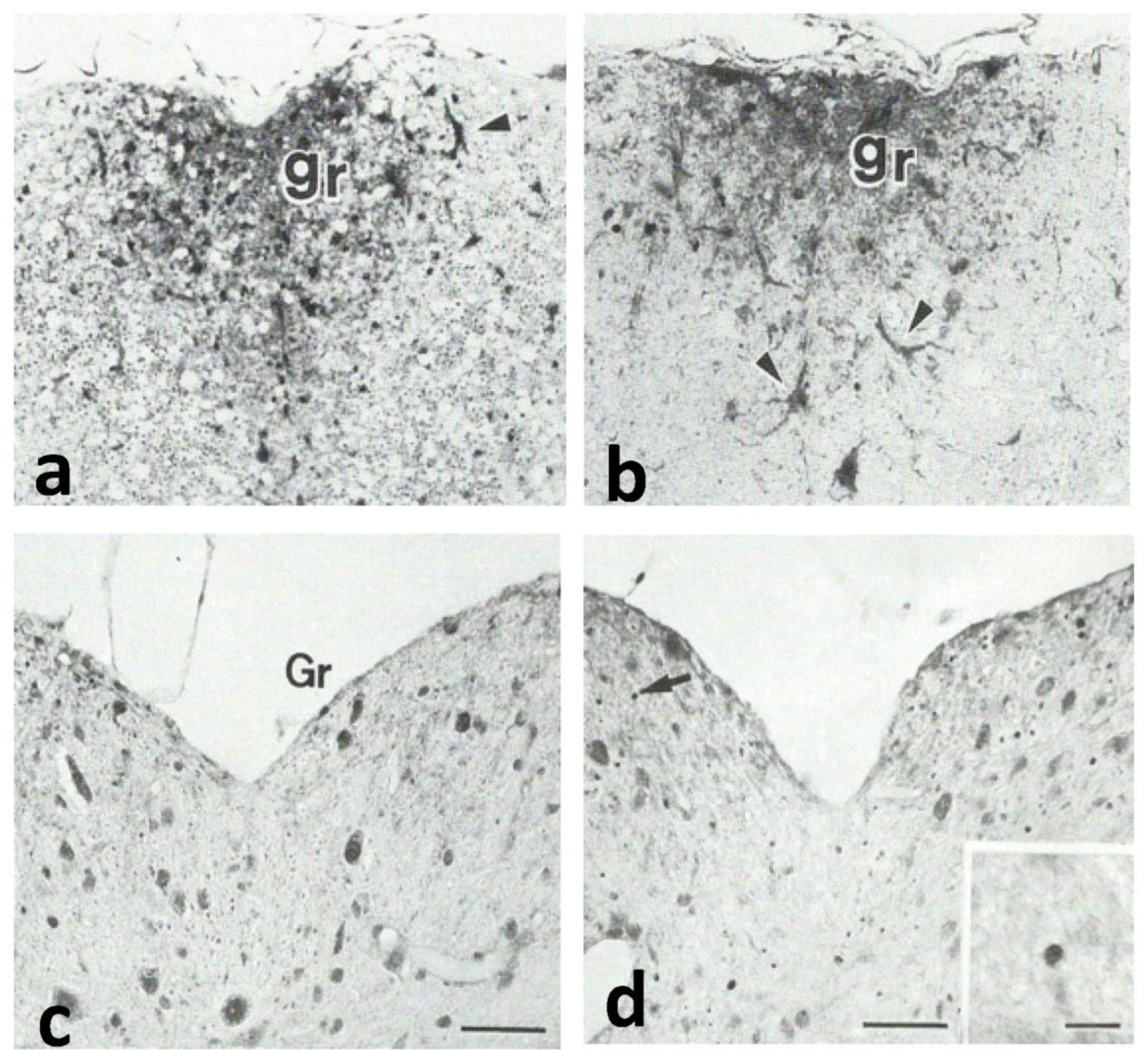1.
Introduction
Metallic sandwich panels and composite materials are increasingly being implemented in military vehicles, marine vessels, and aerospace structures. The possibility of energy absorption in composite materials with lightness is considered an efficient factor under impact loads. Improving the armor resistance against ballistic threats and minimizing impact hazard are fundamental objectives in applied mechanics. It is essential to mention that energy absorption is playing a substantial role in this regard. One of the significant structures that deal with energy absorption is sandwich panels. They can be described as structures that have light and complex bodies with two plates on both sides and a light core made of various materials with a wide assortment of geometrical shapes [1]. Despite the noticeable lightness of sandwich panels, these panels have a considerable ability to resist all types of pressure and impact loading [2].
The honeycomb structure is one of the adequate cores used in sandwich panels. This structure has high competence and capacity to function in many applications associated with energy absorption, soundproofing, heat insulation, and radiofrequency protection [3]. Honeycomb cores have been the research matter for many years due to their special properties. There have been many studies regarding honeycomb structure properties and behaviors under different loading. For instance, Goldsmith et al. [4,5] conducted experimental study to examine the deformation, perforation, and energy absorption characteristics of aluminum honeycomb structures subjected to ballistic impact by various projectiles. They investigated the effect of impact velocity, size and shape of the projectiles in addition to boundary conditions on the ballistic limits and energy loss of these honeycomb structures. Nia et al. [6] exhibited an analytical formulation to calculate the ballistic limit velocity of metallic honeycomb structures after preforming experiments to detect the ballistic resistance of aluminum honeycomb panels subjected to cylindrical steel impactors.
On the other hand, utilizing composite materials in armors design is an accepted practice to enhance the impact resistance of armors. Those materials have reached a steady increase in the number of applications in military vehicles, marine vessels and aerospace structures [7,8]. Composites provide several advantages over metals such as enhanced strength, stiffness, and impact resistance [9]. However, laminated composite plates are more susceptible to impact damage compared with similar metallic plates [7,8,9].
A constant concern for composite materials that used in armor systems is the effect of high-speed objects on the behavior and failure criteria of these composites because significant damage can occur. Limiting the use of composite materials for ballistic armors is due to the influence of impact loads on the performance and response of these composite structures. Generally, energy is absorbed through elastic and plastic deformations which result in permanent deformation in the material structure. In recent years, a significant amount of research has considered experimental and theoretical approaches to study the ballistic impact response of composite laminates in order to gain a deep intuitive understanding of the energy absorption and failure criteria. The ballistic performance of a composite laminate signifies its ability to absorb energy during a high-velocity impact [7,10]. For instance, García-Castillo et al. [11] developed a nondimensional formulation of an analytical technique proposed in a previous work of García-Castillo et al. [12]. This method studied the ballistic behavior by estimating the projectile's residual velocity, ballistic limit, energy absorbed during penetration, and contact time between projectile and laminate by depending on energy criteria of woven composite laminates with E-glass fibers. Good agreement was found for residual velocities, contact time and ballistic limit for two geometry ratios. Lahuerta et al. [13] used an experimental approach to compute the delamination length in mode-Ⅰ tests depending on the video image processing. Their results depicted that visual image processing was a steady method for simplifying the post-processing of static and fatigue mode Ⅰ tests. Further, Hasan Malik et al. [14] performed an experimental study to compare the mechanical and ballistic performance of composites reinforced with single-layer and double-layer inter locked woven fabrics. Kevlar multifilament yarn was used for preparation of all the fabric structures, and epoxy resin was used as the matrix system. The energy absorption and mechanical failure behavior of composites during the impact event were found to be strongly affected by the weave design of their enforcement. The composites reinforced with double-layer interlocked woven fabrics were found to perform better than those comprising single-layer fabrics in terms of impact energy absorption and mechanical failure. Likewise, Sultan et al. [15,16] studied the influence of different thicknesses on fiberglass reinforced epoxy laminates subjected to high velocity impact loading. Their ballistic test results indicated that the plates with more layers of C-glass/epoxy can absorb more impact energy. The result clearly reveals that impact damage was in the form of breakage and cracking of fiber and matrix. As a result, the major parameters that affect the response and behavior of composite materials under low-velocity and high-velocity impact loads can be: the contents, geometry, and characteristics of the fiber as well as the matrix properties, number of layers of composite material, and stacking sequence of layers.
The aim of this study is to develop new generation of advanced armors with high performance and more resistance against ballistic impacts. The novel proposed hybrid structure design in this research involves combinations of metal honeycomb structure as a core sandwiched between polymer composite layers. The traditional armors widely used in defense are made of either metal or polymer composites. Several previous ballistic impact studies considered sandwich panel armors with honeycomb core and two metal plates on both ends, while other literature focused on the behavior of composite laminates armors only. However, in this manuscript, a novel armor structure design is proposed by combining both metal honeycomb core with polymer composite layers to produce a new generation of composite armors. We believe that combining honeycomb sandwich panels with composite materials can introduce a new structure which will simultaneously benefit the properties of these two components. Thus, in the current research, we evaluated various types of metal honeycomb cores and composite materials layers to optimize the final hybrid armor design. Each step of the designed structures is verified with experiments to validate the developed model. We focus on developing new armor design, investigating optimum failure criteria, and exploring the effect of changing the materials on the ballistic impact, residual velocity, and absorbed energy. Composite armor structure deformation behaviors during ballistic impact via armor piercing projectile with 0.3 caliber are observed at various velocities. The proposed armor represents a step towards introducing a new armor system for high performance ballistic threats which can be used for military vehicles, aircrafts, marine vehicle, and other defense applications.
2.
Numerical model
To shed light on the energy absorption and residual velocity of various composite sandwich panels under ballistic impact loading, this study implements constitutive models for three-dimensional finite element modeling procedure of a sandwich structure consisting of two plates of laminated composites with aluminum honeycomb structure core when subjected to normal ballistic impact by a rigid projectile. The FE simulation through LS-DYNA software is capable of computing the dynamic impact response for composites and metals, and provides a relatively simple framework for predicting ballistic impact deformations and response, and breakage of materials associated with high velocity impact loads. The finite element model is validated to previously published laboratory test data. Various types of aluminum materials, composite materials (considering woven and unidirectional laminates), and a range of velocity impact loading are investigated in this study.
2.1. Projectile material model
The steel projectiles were modeled with solid elements. The projectile material modeling was considered to be a non-deformable (rigid) projectile by using MAT_RIGID [17] in the present study. This consideration is valid for projectiles made of materials with adequate hardness. Moreover, negligible amounts of deformation of the impacted face of the projectiles were observed in previous experiments [18,19]. Thus, rigid projectile assumption is adequate in this case. Further, the current numerical simulations are compared with the published impact test data [18,19] to validate the assumption and the results.
2.2. Composite material model
Material model type MAT_ENHANCED_COMPOSITE_DAMAGE [17] was considered to simulate composite material response and capture progressive damage under high velocity impact loading condition. Hashin's failure criteria [20] were considered in the present analysis. The numerical outcomes were compared with the experiments to confirm the appropriateness of the material model and the failure criteria that were selected to simulate the impact of composite targets.
2.3. Honeycomb material model
Composite sandwich panels with metallic honeycomb core subjected to high-velocity impact were investigated in the current analysis. The aluminum honeycomb structure was simulated using material model type MAT_SIMPLIFIED_JOHNSON_COOK [17]. Johnson-Cook [21] constitutive model of strain sensitive plasticity was implemented for metallic sections of the target. The results of the selected material model were compared with the experimental data to examine the accuracy of the simulation outcomes.
2.4. Finite element simulation
In this study, a finite element modeling of a ballistic impact process of composite sandwich armor assembled from aluminum honeycomb core and composite plates subjected to high-velocity impact of rigid projectile was simulated in a software program LS-DYNA. The bullet axis is positioned perpendicular to the armor plane. Impactor is made of an isotropic material with elastic properties (i.e., Young's modulus and Poisson's ratio). While target consisted of two parts: honeycomb core and composite plates. The honeycomb core material has elastic and plastic properties, while composite plates contain anisotropic materials. Properties of impactor are assigned using rigid material whereas Johnson-Cook [21] plasticity theory is used to incorporate honeycomb properties. The composite sections of the target are modeled using Hashin damage criterion [20]. Composite layup defines all details of one element layer including material of ply, number of plies, stacking direction of plies, and orientation of ply. Composite shell elements with four nodes were used for the composite plate mesh, while solid elements with 8 nodes were considered for the honeycomb core mesh. The dimension of the target was 50 × 50 mm and the number of plies used in each composite plate depending on the plate thickness of 5.44 mm. While the honeycomb core dimensions were 50 × 50 × 19.15 mm, as shown in Figure 1.
An armor piercing projectile APM2 with 0.3 caliber is simulated in LS-DYNA in order to be used as impactor in this research. The impactor was considered as a rigid body in the simulation. The bullet has a cylindrical part with a diameter of 7.62 mm and a conical part making a total height of the bullet is 27.6 mm. The bullet mesh is created using ten-node tetrahedral elements. The case considered here is identical to the base case analysis for the composite sandwich armor study, which is discussed later in this article.
The contact behavior between different parts of the sandwich panel along with the impactor is defined in the contact module of LS-DYNA. A surface to surface contact solution with frictional coefficient of 0.2 is used to define the contact behavior between the bullet and the sandwich armor parts. The proposed frictional coefficient was considered after several numerical simulations trails with various values to align with the experimental outcomes. In order to define the interaction between the bullet and the sandwich armor, surface to surface interaction is created by defining respective master and slave parts and using above described frictional coefficient. Regarding interaction behavior between the composite plates and the honeycomb core, tiebreak constraints (i.e., fully bounded contact is active for nodes which are initially in contact and tangential motion is inhibited) are assigned between their surfaces. The boundary conditions of the FE simulations are applied on the edges of all sandwich panel parts, where all degrees of freedom (i.e., three translations and three rotations) are fixed.
The residual velocity and energy absorption results from finite element simulations were compared to those obtained from experimental test data, which is discussed later in this article. This study demonstrated that FE simulation models, shown in Figure 2, were able to show good agreements with the laboratory test results.
2.5. Comparison with experimental data
The validation for the FE simulations for the sandwich panels in this research was divided into two categories: one for the composite plates, and the second one for the honeycomb structure. The validation for the composite materials presented herein makes use of experimental test results conducted by Deka et al. [18] on a composite plate of E-glass and polypropylene subjected to impact loading from a single-stage light gas gun used to launch the projectile. The projectile, with a flat-ended cylinder made of steel, was applied on 8-layer laminates where each layer thickness was 0.68 mm. In this study, a finite element model is developed to simulate the experimental case of 8-layer laminates target subjected to a rigid steel projectile having a radius of 3.98 mm, length of 6.96 mm, density of 7860 kg/m3, Young's modulus of 210 GPa, and Poisson's ratio of 0.28, with an incident velocity of 356 m/s. Table 1 shows the material properties of the E-glass/PP composite layer that is used in this FE simulation. The FE model predictions of residual velocity and energy absorption are validated with the experimental test results. The FE model with composite shell elements described earlier was utilized to simulate the model tests of composite plates. The comparison between the experimental and numerical simulations results for the projectile impact on composite laminates showed a good agreement with minimal deviation of 0.8% in residual velocity and 2.4% in energy absorption.
The second validation of carbon fiber composite plate that presented in this article makes use of experimental investigation results under impacts. This investigation proceeded by Ahmad et al. [22] on a composite plate of unidirectional carbon fibers Toray T800 impregnated in epoxy resin subjected to impact loading from a mini-drop tower machine. The cylindrical impactor with a hemi-spherical head, having a radius of 6.5 mm with impact velocity of 3.71 m/s and an impact load of 3.44 kg, corresponding to 23.62 J, was applied on the 8-ply laminated plate specimen of 125 × 125 × 1.5 mm with [0/90/0/90]2 stacking sequence. In this study, a finite element model is developed to simulate this experimental test. Table 2 shows the material properties of CF-T800/epoxy that is used in this FE simulation.
The third validation was considered the experimental impact data of Kevlar-129/epoxy composite plate that was conducted by Starratt [23]. The target of 8-layer Kevlar-129/epoxy with dimensions 203 × 203 × 2 mm was impacted by blunt-tipped cylindrical projectile made of aluminum 6061-T6 with a diameter of 5.39 mm and a weight of 2.79 g having an initial velocity of 428 m/s. The mechanical properties of Kevlar-129/epoxy composite are shown in Table 3. The comparison between the results of experimental and FE data for the impact on this Kevlat-129/epoxy composite plate showed a good agreement with minimal deviation of 1.8% in residual velocity and 4.2% in energy absorption.
The final validation focused on the impact behavior and response of honeycomb structure by utilizing the experimental test results performed by Hassanpour Roudbeneh et al. [19] The experimental tests used 5052-aluminum honeycomb structure subjected to impact loading from a rigid flat-ended cylindrical (60 RC hardness) projectile having 15 mm length, 10 mm diameter, 8.5 g mass, 210 GPa Young's modulus, and 0.36 Poisson's ratio, with 54 m/s impact velocity. Table 4 shows the material properties of 5052-H38 aluminum that was used in this simulation.
The FE model with solid elements described earlier was implemented to simulate the model tests of the honeycomb structure. The comparison between the experimental and numerical simulations results for the flat-ended projectile impact on the 5052-H38 aluminum honeycomb core showed a good agreement with minimal deviation of 0.2% in residual velocity and 1.3% in energy absorption, where the residual velocity for the experimental test was 47 m/s and the one for the numerical simulation was 46.9 m/s. The numerical simulations results and experimental outcomes for all cases are shown in Table 5.
Overall, the finite element simulation results matched well to the aforementioned experimental test data, indicating good applicability of the developed finite element modeling in subsequent simulations of ballistic impact problems.
3.
Results and discussion
3.1. Honeycomb material selection
Several commercially available aluminum alloys are explored in order to optimize the best material selection for the honeycomb core of the sandwich panel. The aforementioned validated finite element simulation of honeycomb structure is used to investigate the influence of changing the mechanical properties of each aluminum alloy type on ballistic response. Besides 5052-H38, aluminum alloys of 2024-O, 6061-T6, and 7039 are investigated. These alloys are widely used in defense and aerospace applications. For this purpose, the mechanical properties of each aluminum alloy are updated in the validated model of the honeycomb structure according to Table 6.
The ballistic resistances of the honeycomb structure with different aluminum alloys are compared in Figure 3. This ballistic resistance can be defined as the difference of impact and residual velocity over the impact velocity of the projectile. It can be observed that the ballistic resistance of each honeycomb is substantially affected by the types of aluminum alloy. Hence, the mechanical properties of these aluminum alloys play an important role in the ballistic resistance of honeycomb structure under impact loading. Those results highlight the fact that the selection of a specific type of aluminum is a critical decision for the design of ballistic impact structures for defense and aerospace applications. From the results, it can be observed that the proportion of ballistic resistance by 7039-aluminum alloy were relatively higher. However, the properties of all aluminum alloys regarding the values of Young's modulus and density are approximately close. The yield stress played a predominant role in increasing the impact resistance of the alloy.
According to the ballistic resistances in Figure 3, 7039-aluminum alloy offered higher ballistic resistance compared with the other aluminum alloys used in this research. Thus, 7039-aluminum is selected to be used for the honeycomb core of the sandwich panel target in this work. Obviously, the ballistic impact resisted by an individual component such as the honeycomb of the desired armor can be extracted from the FEA results to investigate the contribution from each component towards the formation of the hybrid composite sandwich structure armor.
3.2. Composite sandwich panel
The finite element simulation results of the composite sandwich armor model made of 7039-aluminum honeycomb core with top and bottom composite plates having different materials subjected to various impact velocities with total of eight impact velocities (100,200,300,400,500,600,700, and 800 m/s) are conducted. The composite materials considered in this investigation are E-glass/PP, Kevlar-129/epoxy, and CF-T800/epoxy. Deformation and failure behaviors of the composite/metal sandwich armor structures during impact loading are observed at various velocities. Residual velocities, kinetic energies, absorbed energies, and ballistic resistance are computed and compared for different impact velocities. Figure 4a-c represent the change in kinetic energy of projectile during impacting the armors. The results showed that the material type of the core for the composite armor influenced the behavior of armors pertaining to energy absorption proportions by individual components of hybrid armors. While the CF-T800/epoxy composite had less effect on absorbing the kinetic energy from the ballistic impact of a bullet under different velocities as shown in Figure 4b, the E-glass/PP composite showed a promising behavior in absorbing the energy of the bullet as shown in Figure 4a. The best performance was presented by the hybrid armor with Kevlar-129/epoxy composite, as shown in Figure 4c, which has less density compared to the other composites while its tensile and compressive strengths are higher. While Figures 5 and 6 illustrate the residual velocities and residual kinetic energy of the projectile. From the results, it can be noticed that the hybrid sandwich armor with Kevlar-129/epoxy composite has an intense capability to absorb the ballistic impact compared to the other types of composite armors. While the sandwich armors with the E-glass/PP and CF-T800/epoxy composites show perforation occurs when the projectile passes through the target after the velocity of 100 m/s, the armors with the Kevlar-129/epoxy composite resist the impact of the bullet until the velocity of 500 m/s. In addition, Figure 5 depicted that the velocity increase of the ballistic projectile can lead to reduce the difference in the residual velocity between the Kevlar-129/epoxy composite and the other composites that formed the hybrid sandwich composite armor.
The influence of changing the impact velocities on energy absorptions and ballistic resistance of various armors are presented in Figures 7 and 8 respectively. The energy absorbed by composite sandwich panel armor is calculated using initial impact velocity and residual velocity of the impactor as follows:
where: m = mass of impactor, Vi = impact velocity, Vr = residual velocity.
At velocity of 100 m/s, all composite armor types were able to stop the projectile by absorbing its impact energy. As the velocity increased to 200 m/s, there was no penetration in Kevlar-129/epoxy, unlike E-glass/PP and CF-T800/epoxy. The penetration occurred in E-glass/PP introduced residual velocity of 96.2 m/s (Figure 5), residual kinetic energy of 26 J (Figure 6), absorbed energy of 76.7% (85.5 J) (Figure 7), and ballistic resistance of 52% (Figure 8), while the penetration of CF-T800/epoxy produced residual velocity of 161.8 m/s (Figure 5), residual kinetic energy of 73 J (Figure 6), absorbed energy of 34.5% (38.5 J) (Figure 7), and ballistic resistance of 19% (Figure 8). Although penetration happened in both E-glass/PP and CF-T800/epoxy at same velocity, E-glass/PP was able to absorb more energy and have higher ballistic resistance which left less residual velocity in the projectile. By further increase of velocity up to 500 m/s, Kevlar was able to stop the projectile with full energy absorption, as presented in Figures 4c and through Figure 8. At 600 m/s, the projectile was able to penetrate through Kevlar with residual velocity of 201.2 m/s and residual kinetic energy of 113.9 J, meaning that the armor was able to absorb energy of 88.6% and introduce ballistic resistance of 66.5%.
A linear increase in the residual velocity and residual kinetic energy with respect to incident velocity was introduced beyond 500 m/s in the Kevlar/epoxy and beyond 100 m/s in the E-glass/PP and CF-T800/epoxy. On the other hand, ballistic resistance and energy absorption percentages decease by increasing the impact velocity above 100 m/s, 500 m/s, and 100 m/s for Kevlar/epoxy, E-glass/PP, and CF-T800/epoxy, respectively. However, there duction in ballistic resistance and energy absorption percentages become minimal (≤3%) beyond 400 m/s for both E-glass/PP and CF-T800/epoxy. It is important to mention that although the percentages of absorbed kinetic energy percentages reduce by increasing impact velocity (see Figure 7). The values of absorbed energy increase see Figure 9.
The armor ballistic limit is the maximum velocity at which the armor can stop the projectile from penetration. According to this definition, Kevlar-129/epoxy composite plates with 7039-aluminum honeycomb core have a ballistic limit of 500 m/s. While both E-glass/PP and CF-T800/epoxy with 7039-aluminum honeycomb cores introduced the same ballistic limit response of 100 m/s. However, the hybrid composite armor with E-glass/PP showed better energy absorption and ballistic resistance compared with CF-T800/epoxy. On the other hand, it is important to mention that introducing different ballistic limits by maintaining same composite matrix (epoxy) with different fibers (CF-T800 and Kevlar-129) reflected the influence of the fibers on the energy absorption mechanisms. To this end, hybrid sandwich armor made of 7039-aluminum honeycomb core with top and bottom composite plates of Kevlar-129/epoxy highlights the best performance among other armors' designs introduced in this investigation.
The performance of hybrid composite armor with Kevlar-129/epoxy end plates and 7039-aluminum alloy honeycomb core is observed in further details to shed the light on the performance of this proposed hybrid armor. The structure deformation behavior sat the projectile final position are presented in Figure 10a-f for velocities from 100 to 800 m/s. No penetration was observed for velocities of 100 m/s and 200 m/s in Figure 10a, b, respectively. While incident velocity of 300 m/s, in Figure 10c, introduced a perforation in the hybrid armor by penetrating top plate and reaching almost halfway through honeycomb. Increasing impact velocity to 400 m/s causes the projectile to penetrate further through the hybrid armor until it stopped by approaching the armor bottom plate without damaging it, Figure 10d. At higher velocity of 500 m/s, the armor bottom plate plays significant role in stopping the projectile after small portion of the projectile pass through the plate, see Figure 10e. By increasing impact velocity to 600 m/s or higher, the projectile fully penetrates the hybrid armor with some residual velocity left in the projectile as shown in Figure 10f.
As projectile impacts the armor, most deflections are concentrated in the projectile velocity direction. The distributions of deflection along the honeycomb composite armor when impacted with various velocities are observed. It is noticed that at initial velocity of 100 m/s, the bullet causes minor deformation (without perforation) at the armor top composite plate when the projectile reaches its maximum point through the armor, Figure 11a. As the projectile rebound, the armor dissipates the absorbed energy and recovers its original position, due to armor elastic behavior. This reduces the armor initial deformation introduced by the projectile, and thus the armor ends up with minimal permanent deformation, as shown in Figure 11b. It is important to mention that the honeycomb introduces a noticeable deformation recovery after the projectile rebounds, see Figure 11c, d for honeycomb at maximum deflection and after projectile rebounds, respectively. Thus, the honeycomb structure plays significant role in assisting the top composite plate to dissipate the absorbed energy and recover its original position.
Similar behavior is observed when impacting the hybrid composite honeycomb armor at velocity of 200 m/s, see Figure 12. Although the hybrid armor recovers its original place after projectile rebounds in both velocities 100 m/s and 200 m/s, a higher deflection is introduced by increasing the velocity to 200 m/s, as presented in Figure 12a, b. Moreover, there was no (or very minimal) breakage observed in the honeycomb at 100 m/s, while there is a noticeable breakage occurs in the honeycomb when the armor impacted with velocity of 200 m/s, see Figure 12c, d. This damage is the armor mechanism to dissipate the higher absorbed energy at 200 m/s.
Increasing impact velocity to 300 m/s results on perforation in the top composite plate and noticeable damage on the top section of honeycomb core, as presented in Figure 13a, c, respectively. The projectile tip reached halfway through the honeycomb structure only. There is no sign of deformation along the bottom composite plate, see Figure 13b. At this velocity limit, both honeycomb and top composite plate are able to dissipate the absorbed energy and handle the deflection caused by the impact without transferring any portion of the absorbed energy and deflection to the bottom composite plate. It is important to mention that the bullet is setup to be perpendicular to the armor target before the start of all simulations. The initial bullet velocity is assigned to be in z-direction. At the impact velocity of 300 m/s, the simulation shows that the armor is able to deviate the bullet from its perpendicular direction as the bullet tries to penetrate the armor. This assists in stopping the bullet and leads the bullet to be settled inside the armor structure.
The velocities below 400 m/s show no sign of deformation or energy transformation to the bottom composite plate. At 400 m/s, more damage occurs in the honeycomb and top plate as they try to absorb the additional energy of the projectile that passes through the armor, see Figure 14a, c. However, both structures, i.e., top composite plate and honeycomb, become unable to take care of the entire energy introduced by the new higher velocity. In this stage, the bottom composite plate starts to play a significant role in hindering the projectile motion by absorbing the energy left in the projectile as it tries to find its way through this plate. Thus, a small deflection without any perforation is introduced to the bottom composite plate of the hybrid armor, as presented in Figure 14b, while the entire projectile is embedded in the armor structure.
The hybrid composite armor is still able to handle additional increase in the projectile velocity up to 500 m/s. At this velocity, a perforation at the bottom composite plate, Figure 15b, combined with additional damages in the top composite plate Figure 15a, and honeycomb structure Figure 15c, to dissipate the projectile's energy and stop it. In this case, it is observed that the entire projectile is settled inside the armor structure. Introducing higher impact velocity of 600 m/s to the hybrid composite armor with honeycomb core results in penetrating the projectile through the entire armor structure including the bottom composite plate which indicates passing the armor ballistic limit, as explained in previous section.
4.
Conclusions
Several hybrid designs of metal honeycomb with composite laminates were developed and evaluated to optimize an outstanding ballistic structural armor. Four metal alloys and three composite laminates were considered in this investigation in order to evaluate the technical feasibility of the proposed armor design. Changing the composite material types was found to have a moderate to large influence on the magnitude of energy absorption and residual velocities under ballistic impact loading.
Various numerical techniques were implemented to analyze the hybrid composite sandwich armors subjected to high velocity. The numerical approach was successfully employed to predict the impact behavior after validating these models with experimental test results. The aluminum 7039 alloy was selected for the honeycomb core material since it offered a higher ballistic resistance compared with other aluminum alloys considered in this research. While, Kevlar-129/epoxy was the best candidate for composite plates as it presented an outstanding ballistic limit with respect to CF-T800/epoxy and E-glass/PP. The results indicated that a hybrid composite armor which consists of 7039-aluminum alloy honeycomb core and two ends Kevlar-129/epoxy composite plates can stop a 0.3 caliber Armor Piercing projectile APM2 at velocity of 500 m/s, which is the ballistic limit for this hybrid composite armor. Whereas, considering CF-T800/epoxy or E-glass/PP instead of Kevlar-129/epoxy in a hybrid composite armor with 7039-aluminum alloy honeycomb introduces a ballistic limit of 100 m/s for that specific armor. Although both E-glass/PP and CF-T800/epoxy hybrid armors have same ballistic limits, E-glass/PP exhibits higher energy absorption and ballistic resistance. It is important to mention that fibers play significant role in the energy absorption mechanisms, i.e., Kevlar-129/epoxy ballistic performance is better than CF-T800/epoxy.
The developed models can assess in reducing expenses associated with developing special process and equipment to evaluate the ballistic armor since those simulations have the ability to predict the ballistic limit and the armor's behavior as well as provide significant insights about the armor design development.
Acknowledgements
This work was supported by the U.S. Department of Defense (DOD) (Grant number W911NF1810478). The use of resources provided by Texas A&M University-Kingsville is acknowledged.
Conflict of interests
The authors declare no conflicts of interest in this paper.
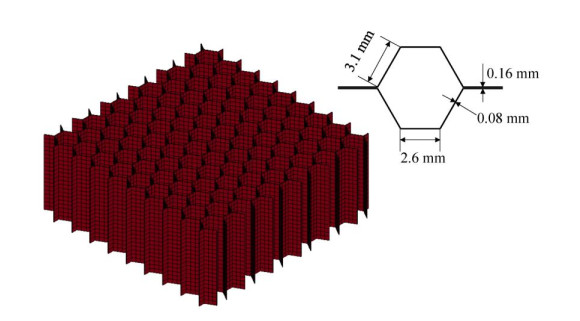









 DownLoad:
DownLoad:
